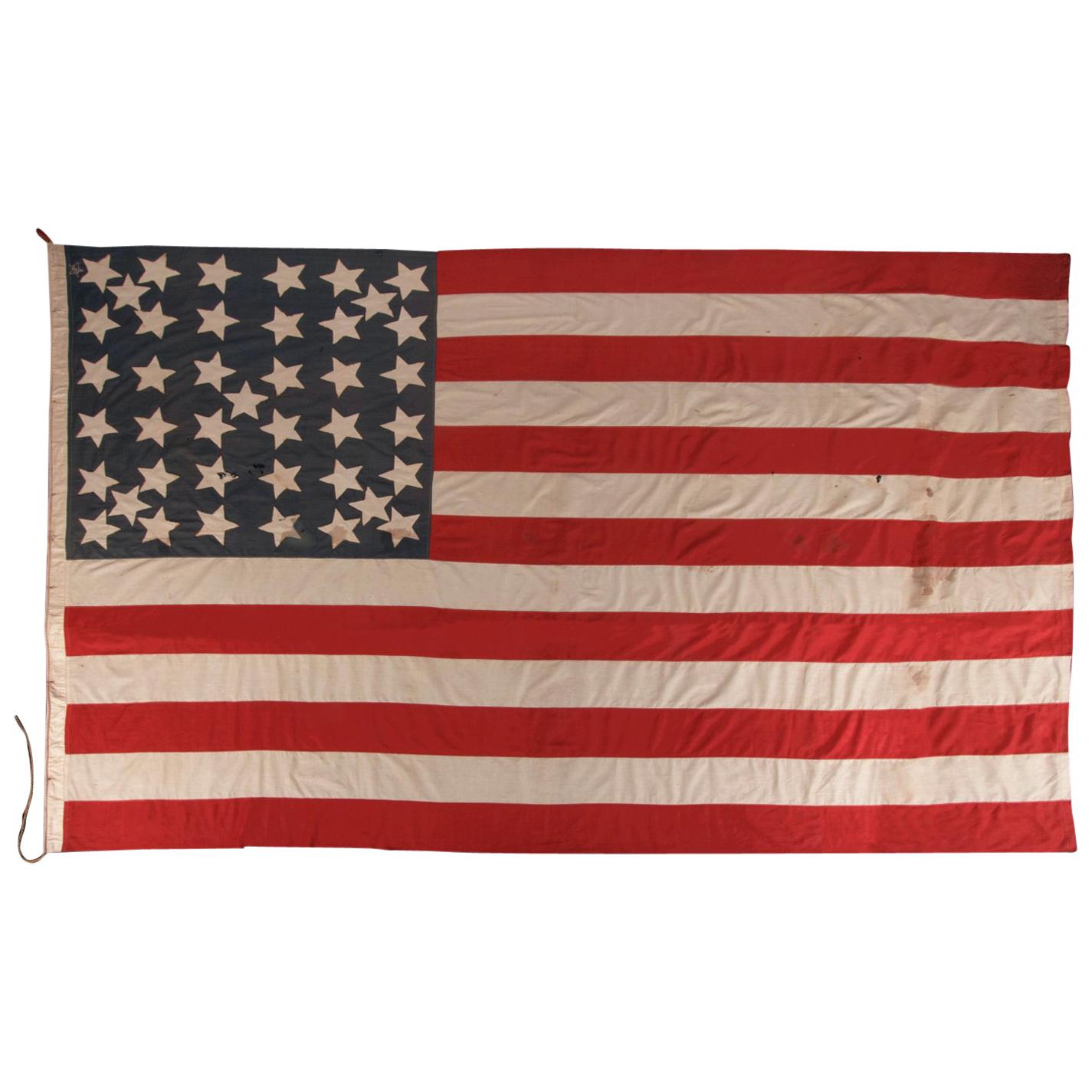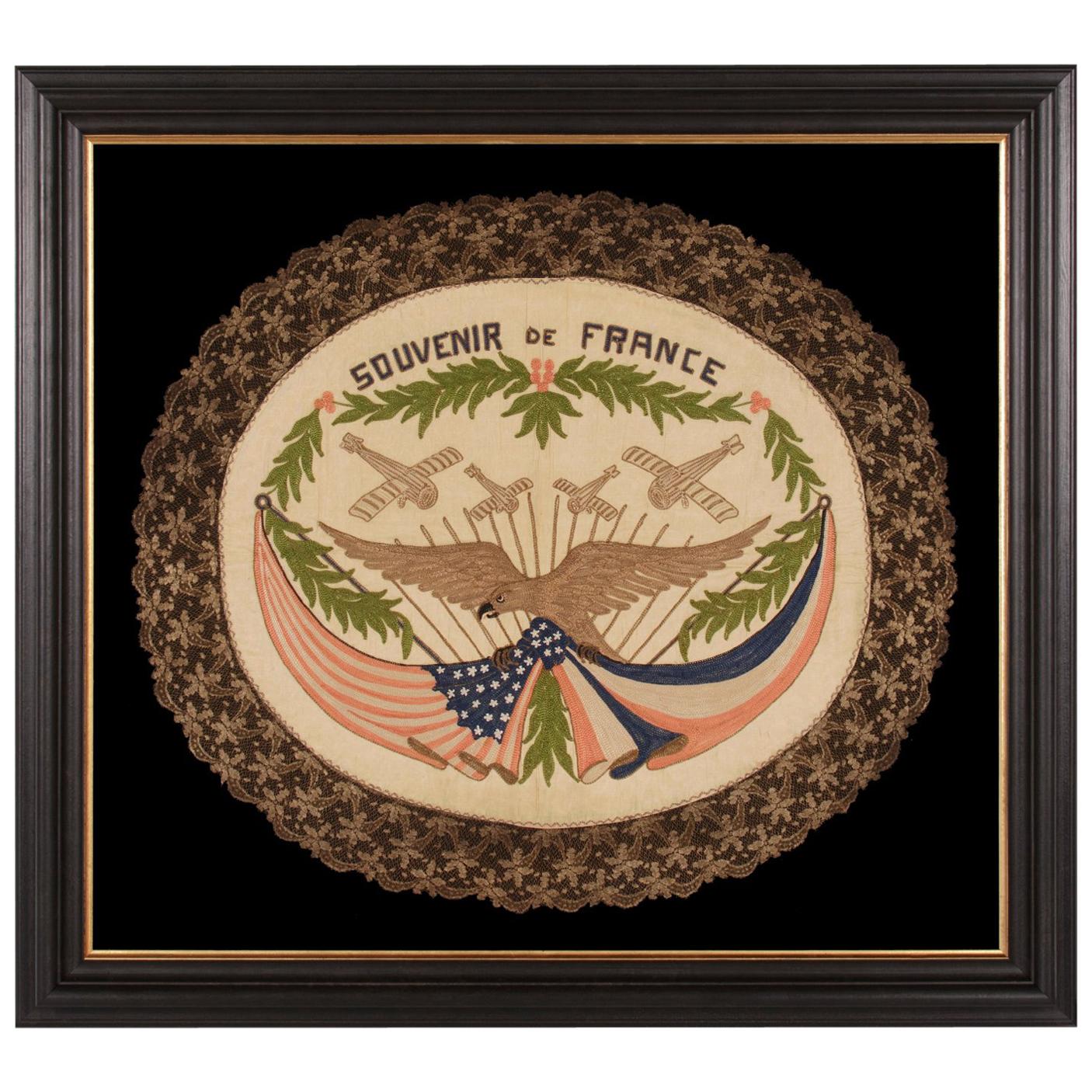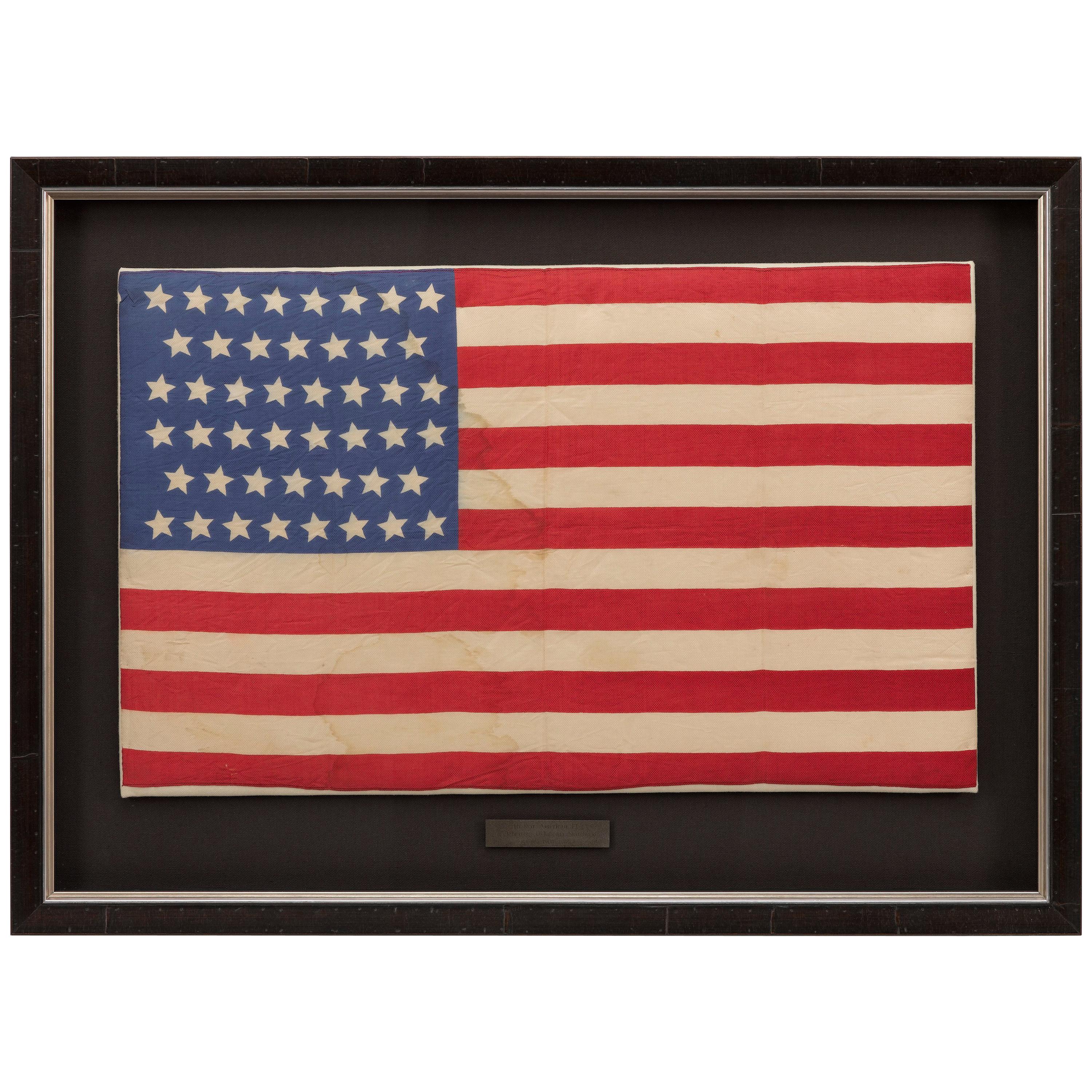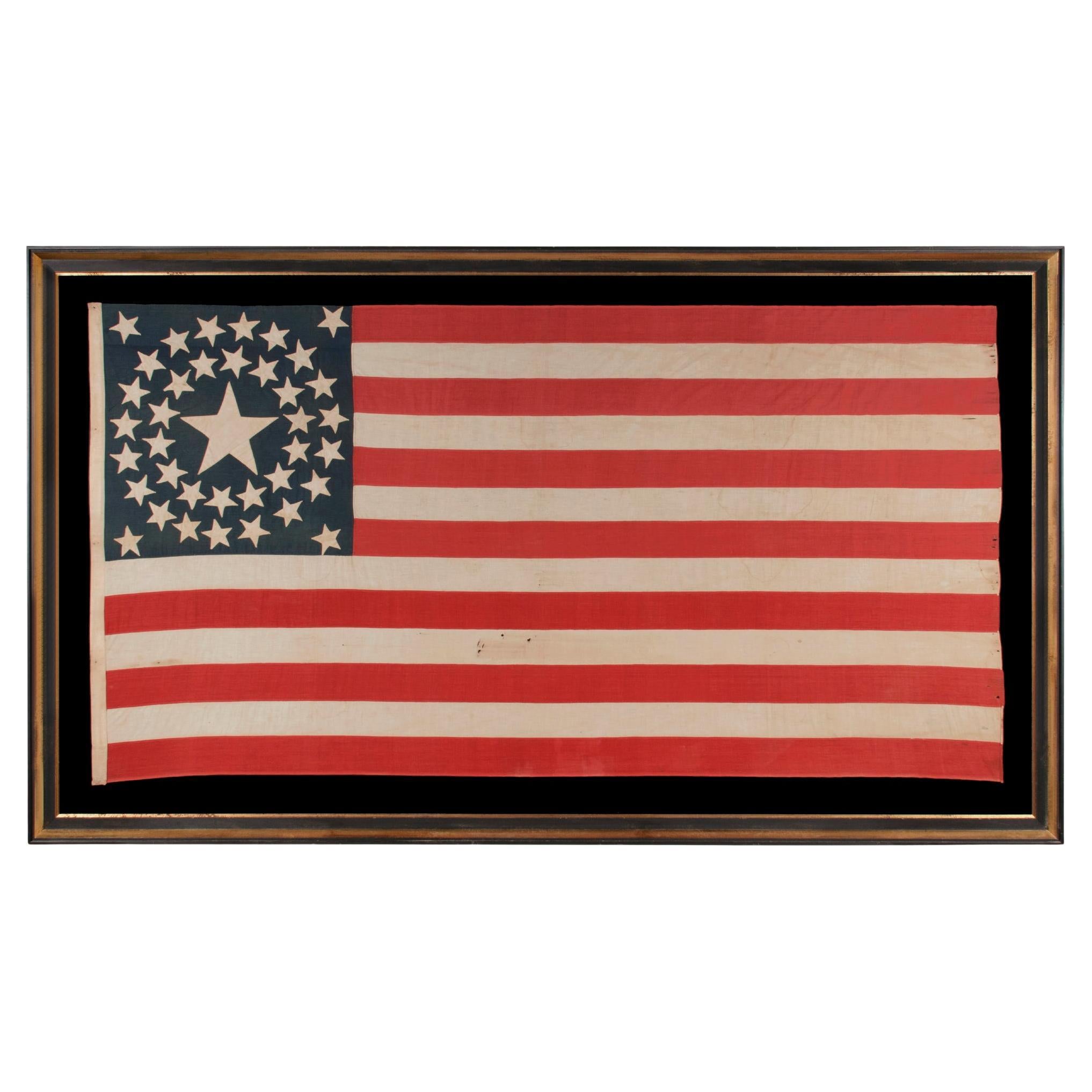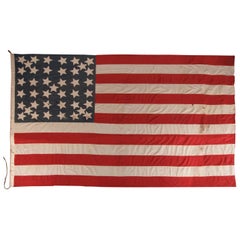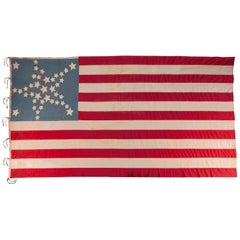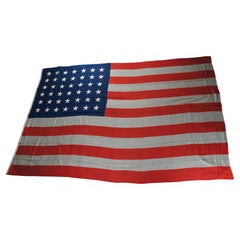
37 Single Appliqued Stars on an Antiques American Flag
View Similar Items
Want more images or videos?
Request additional images or videos from the seller
1 of 7
37 Single Appliqued Stars on an Antiques American Flag
About the Item
- Dimensions:Height: 56 in (142.24 cm)Width: 81 in (205.74 cm)Depth: 2.5 in (6.35 cm)
- Place of Origin:
- Period:
- Date of Manufacture:1867-1876
- Condition:See Item Description.
- Seller Location:York County, PA
- Reference Number:Seller: 37j-8411stDibs: LU84978795963
About the Seller
5.0
Recognized Seller
These prestigious sellers are industry leaders and represent the highest echelon for item quality and design.
Established in 1991
1stDibs seller since 2008
61 sales on 1stDibs
Typical response time: 10 hours
More From This SellerView All
- Antique American Flag, 32 Stars, Minnesota Statehood, ca 1858-59Located in York County, PA32 STARS IN A VERY UNUSUAL NOTCHED VERSION OF THE “GREAT STAR” PATTERN, WITH TWO STARS ABSENT AT THE EXTREME POINTS OF EACH ARM, MADE IN THE PERIOD WHEN MINNESOTA JOINED THE UNION AS...Category
Antique 1850s American Political and Patriotic Memorabilia
MaterialsCotton
- 41 Stars In a Lineal Pattern With Offset Stars, Montana Statehood American FlagLocated in York County, PA41 STARS IN A LINEAL PATTERN WITH OFFSET STARS THAT CREATE A CROSSHATCH IN THE CORNERS AND CENTER, ONE OF THE RAREST STAR COUNTS AMONG SURVIVING FLAGS OF THE 19TH CENTURY, REFLECTS MONTANA STATEHOOD IN NOVEMBER, 1889, ACCURATE FOR JUST 3 DAYS: Numerous flags appeared with unofficial star counts in early America, produced by flag-makers in anticipation of the addition of more states. The 41 star flag...Category
Antique 1880s American Political and Patriotic Memorabilia
MaterialsCotton
- 34 Star American flag, Updated to 39 Stars, with Stars in a Great Star PatternLocated in York County, PA34 STARS IN A WHIMSICAL RENDITION OF THE GREAT STAR PATTERN, ON A CIVIL WAR PERIOD FLAG WITH A CORNFLOWER BLUE CANTON, UPDATED TO 39 STARS IN 1876 34 star American national flag with additional stars added and one of the most stunning graphic designs I have ever seen in early flag-making. The original pattern was comprised of a circle of 5 large stars, and triangular arms made of smaller stars. These are noticeable pointy and bent like the arms of a starfish. Made of cotton, the stars are hand-sewn and double-appliquéd to a fantastic, cornflower blue canton, a color common to Civil War uniforms...Category
Antique 1870s American Political and Patriotic Memorabilia
MaterialsCotton
- 13 Star Antique American Flag with Hand-Sewn Stars in 5-3-5 Pattern, ca 1861-65Located in York County, PAAntique American flag with 13 hand-sewn stars in an extremely rare lineal configuration of 5-3-5, probably made with the intent of use by local militia or private outfitting of a vol...Category
Antique 1860s American Political and Patriotic Memorabilia
MaterialsWool
- 38 Star American Flag, Stars in Notched Pattern, ca 1876-1889Located in York County, PA38 HAND-SEWN STARS IN A "NOTCHED" PATTERN, ON AN ANTIQUE AMERICAN FLAG WITH BEAUTIFUL WEAR FROM HAVING BEEN EXTENSIVELY FLOWN, MADE AT THE TIME WHEN COLORADO WAS THE MOST RECENT STATE TO JOIN THE UNION, 1876-1889 38 star Antique American flag, made during the period when Colorado was the most recent state to join the Union. The stars are arranged in what is known as a "notched" pattern, in which two spaces were left open along the hoist end, in the first and last rows, in anticipation that two more Western Territories would soon join the Union. The latter 19th century was a time of when much of the land in and about the Continental Divide was formalized into states, and there was continual speculation about which ones would be accepted next, and with what boundaries. The stars of the flag are made of cotton and are double-appliquéd (applied to both sides) with a lineal, treadle stitch. The canton and stripes of the flag are made of wool bunting that has been pieced with treadle stitching. The canton was constructed from five separate lengths of fabric, which is an unusual feature, though hardly unknown. To each of these a row of stars was sewn. This manner of construction is sometimes encountered and tends to be an early trait, at least when it occurs in flags of this scale and smaller. When encountered, it also seems to have been preferred in flags meant for maritime use. While the feature does not by any means guarantee this fact, it is a reasonable, educated guess, based upon my examination of many other examples. A flag with a 5-piece canton, such as this, would have been less likelihood to stretch, with increased structural integrity. The alternative is that this was simply an example made when there were at least five pieces of leftover fabric, of a reasonable size to made individual rows, and that what it actually demonstrates is the careful conservation of scarce resources. There is a sailcloth canvas binding along the hoist, with 3 brass grommets, evenly spaced. Perhaps the best feature of the flag is the evidence it displays of having been extensively flown, with the fly end whipped out from wind exposure. While many flags display damage from a combination of having been flown, exposure to the elements, various mishaps, and improper storage, very few exhibit wear such as this, which is both endearingly and visually attractive. This one shows its age beautifully, whipped out along the fly end, with losses that convey an element of movement, that most flags don’t capture in the state in which they survive. Colorado became the 38th state on August 1st, 1876. This was the year of our nation’s 100-year anniversary of independence. Per the Third Flag Act of 1818, stars were not officially added until the 4th of July following a state's addition. For this reason, 37 was the official star count for the American flag in 1876. Flag-making was a competitive venture, however, and few flag-makers would have been continuing to produce 37 star flags, when their competitors were making 38’s. It is for this reason that 38 and 13 stars (to represent the original 13 colonies...Category
Antique Late 19th Century American Political and Patriotic Memorabilia
MaterialsWool
Price Upon Request - 34 TUMBLING STARS on an ANTIQUE AMERICAN FLAG, CIVIL WAR PERIOD, 1861-63, KANSASLocated in York County, PA34 STARS WITH "DANCING" OR "TUMBLING" ORIENTATION, ON AN ANTIQUE AMERICAN FLAG WITH EXTRAORDINARY COLORS, PRESS-DYED ON WOOL BUNTING, LIKELY PRODUCED FOR USE AS MILITARY CAMP COLORS,...Category
Antique 1860s American Political and Patriotic Memorabilia
MaterialsWool
You May Also Like
- 46-Star American Flag, Antique Printed on Silk, Early 20th CenturyLocated in Colorado Springs, COThis is an original 46-star American parade flag, printed on silk. Each star represents a state in the Union at the time. The official flag design would update every July 4th, to inc...Category
Antique Early 1900s American Political and Patriotic Memorabilia
MaterialsSilk
- 39-Star Antique American Flag with 'Whimsical' Star Pattern, 1889Located in Colorado Springs, COThis is a 39-star unofficial American flag, handmade and printed on cotton. The flag dates to 1889 and has a unique history, thanks to its rare star-count. The flag’s canton is prin...Category
Antique 1880s American Political and Patriotic Memorabilia
MaterialsCotton
- Rare Monumental 1890 Antique 42 Star United States of America FlagLocated in Dayton, OHMonumental fifteen foot 42 star American flag, circa 1889-1890. The 42-star flag is rare because only a limited number of 42-star flags were produced after Washington became a state on Nov. 11, 1889. But it takes a more intimate knowledge of flag trivia to know just why it happened this way. White stars are added to the blue field of the star-spangled banner on the Fourth of July after a state is admitted to the union. In the fall of 1889, several western territories became states. Dakota was admitted, and then split into North and South Dakota, on Nov. 2, 1889, which made them state and star numbers 39 and 40. Montana was named the 41st state on Nov. 8, followed by Washington, on Nov. 11. Only a few flag manufacturers began producing 42-star flags before the official addition of the 42nd star on July 4, 1890. Those who tried to jump the gun by being the first to produce an up-to-date flag were surprised when Idaho was admitted to the United States on July 3...Category
Antique 1890s American Classical Historical Memorabilia
MaterialsCotton
- 38-Star Antique American Flag with Unique Canton, circa 1876-1890Located in Colorado Springs, COThis is a striking 38-star American flag. The flag dates to 1876-1890, when Colorado (represented by the large star in the center of the flag’s canton) joined the Union as the 38th s...Category
Antique Late 19th Century American Political and Patriotic Memorabilia
MaterialsMuslin
- 34-Star Civil War American Flag, Antique Great Star Pattern, circa 1861Located in Colorado Springs, COThe stars of this extremely rare, Civil War-era flag are arranged in what is sometimes called the "Great Flower" pattern, a large star made out of smaller stars -- named as such beca...Category
Antique 1860s American Political and Patriotic Memorabilia
MaterialsLinen
$15,500 Sale Price37% Off - Antique 46 Star WMH Horstmann Company United States of America Flag 83"By HorstmannLocated in Dayton, OHAntique forty six star large wool American flag by Horstmann Company, circa 1908-1912. Horstmann firm was founded by William H. Horstmann (1785-1850), who had immigrated to Philadelphia from Germany. Horstmann bought out a local swordmaker in 1828 and thereafter entered the military goods field. The firm benefitted from the Civil War, becoming the largest military goods supplier in the nation by 1864. WILLIAM H. HORSTMANN & SONS, Manufacturers of Dress Trimmings and Military Goods. 5th & Cherry Streets, Philadelphia, PA. This house was founded, in 1815, by William H. Horstmann, a native of Cassel, in Germany. He had learned the trade of silk-weaving in France, and, emigrating to the United States in the above-mentioned year, established himself in Philadelphia as a manufacturer of fringe, laces and trimmings of various kinds. He married the daughter of Frederick Hoeckly, a German settler in Philadelphia, and also a manufacturer of fringe, coach-lace and tassels. He devised several improvements in this trade, especially by introducing varieties in the styles and patterns of this class of goods, there being at that time only two patterns used in the trade, which were known as the Jefferson pattern and the Monroe pattern. In 1824, he introduced into this country from Germany the use of plaiting or braiding machines, and about the same time he was the first to introduce into this country the use of the Jacquard loom, for weaving patterns in textile fabrics. His location was in the first instance at No. 50 North Third street, but within a short time he removed to a store next to the Harp and Crown tavern, afterwards known as the City hotel, and continued his business within a short distance of this point for many years. In 1828, he commenced the manufacture of military trimmings as a special department, and this branch has grown to most important proportions, Horstmann's military goods being in demand throughout time country. The firm have also executed large Government contracts in this line for the War and Navy Departments. In 1831, he established a branch house in New York city, and about the same time erected a factory at the corner of Germantown road and Columbia avenue. The factory was continued here until time erection of the extensive building at Fifth and Cherry streets, where the works, salesrooms and offices of time firm now are. This massive structure is six stories high, and extends 140 feet on Fifth street and 200 on Cherry street, and reaches back to Race street. The separate departments into which the business is divided are thirty in number. More than 1000 distinct looms and machines are in use in the building, many of them very costly and some invented and used exclusively by this firm, the motive power being supplied by a steam engine of fifty horse power. The area covered by the works is about 11,000 square feet. Time number of hands employed is very large, about 500. When the erection of a vast factory at this point was first proposed, a strong opposition was made by time holders of the neighboring property. The ancient German Lutheran Church and burying ground, since removed, stood opposite the site, and a bill was introduced into the Legislature to forbid the use of a steam engine within 100 yards of any place of worship. The interests which such a bill would have affected injuriously, especially those of several newspapers, roused a strong opposition to it, and it failed to become a law. In 1845, William H. Horstmann, the founder of the house, retired from the business, and his two sons, William and Sigmund, assumed the management and it was under their direction that the new building, above described, was erected. The goods produced by this house are of almost endless extent and variety. They include goods woven from all the various textile fibres—cotton, wool, silk, etc.—in every style, color and pattern, and are used for an infinite number of purposes. Narrow woven goods are time staple production, made up into material for dresses for both sexes, for use in daily life, and for regalia for ""societies;"" for the costumes of the stage, the upholstering of houses and of carriages, the uniforms of soldiers, together with equipments for the same, and for funeral purposes. The raw material used in the manufacture is to a great extent very costly, and their store rooms often hold as much as $200,000 worth of goods in an unworked state. There are two rooms devoted to power looms in the factory, one for coach lace and one for other styles of weaving, in which about 250 of these machines are constantly running. The braiding machines in the coach lace room are very noteworthy. The cord to be covered with braid is drawn through an opening in time middle of a flat, circular, metallic plate, about 15 inches across. Up to a point on this cord, about a foot above the plate, the threads of the braiding material converge, like the ribs of a tent-roof, and there weave in and out and out and in, as the coating of braid grows, and time covered cord rises and is wound away above. The weaving is accomplished by the motion of the spools below that carry the different threads of the braid. These spools stand in uprights, which are carried round and amongst each other in curved slots in the above-mentioned broad metallic plate. All but two of these spools run in and out among each other, with a swift, easy and intricate motion, mind so rapid that time eye can hardly follow it, while one or two special spools run steadily round and round among time twisting spools with the most extreme swiftness. Many other machines, displaying equally ingenious mechanism, are used in the factory. The various details of equipment manufactured and supplied by this house are also important, both for their number and the superior quality of the manufacture. The one article of swords may be taken as an instance. This trade grew naturally and immediately out of the established army and navy goods department of the works, it being necessary that the sword itself should be furnished together with the sword-belt and other trappings all complete. Every part of the sword and trappings, with the exception of the blade, is made on the premises. The blades are almost all imported from the ancient German sword-blade emporium of Solingen, where, it is said, swords have been made ever since the year 1147, when Count Adolphus of Berg brought home from the East and established there the business of forging Damascus blades. There is in this department a stock of some thousands of blades, of many different patterns and sizes, ready to be set and finished. Any style or sword can be had from this warehouse, from the plainest kind up to a presentation sword...Category
Vintage 1910s American Classical Political and Patriotic Memorabilia
MaterialsWool
Recently Viewed
View AllMore Ways To Browse
Applique Flag
Flag Bunting
Antique Bunting Flags
Antique Union Flag
Antique Us Flags
Antique Us Flag
Fly Case
37 Star Flag
Appliques And Patches
Colorado Flag
Folded American Flag
American Flag Colorado
Freds Antique Furniture
Nebraska Antique
Early American Stencil
Used Commercial Display Cases
1877 Flag
Antique Round Lighter

